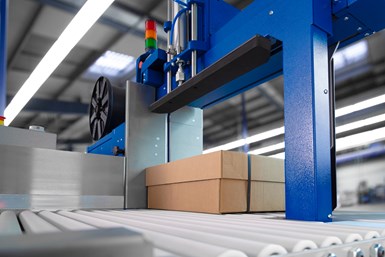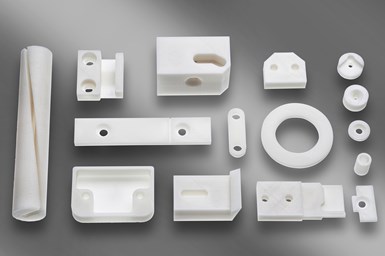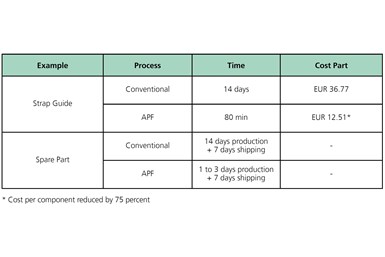Polymer AM Cuts Costs of Small-Batch Replacement Components
Producing replacement parts through polymer AM has cut Mosca’s lead times and component costs to small fractions of their original size, even when producing small batches of parts.

With over 100,000 strapping machines installed worldwide and over 2,000 components in every machine, Mosca ran into trouble developing replacement parts before it turned to additive manufacturing. Photo Credit: Arburg
Mosca, an international manufacturer of end-of-line packaging solutions, prides itself on efficiency, reliability and a customer-oriented outlook. “We have installed more than 100,000 strapping machines worldwide,” says Stefan Kessler, innovation and technology manager at Mosca’s German headquarters in Waldbrunn.
But all machines require replacements for components at some point in their lives, and with over 2,000 individual components in each Mosca machine, the manufacturer found itself hard-pressed to build an inexpensive supply of replacement parts. Reprogramming and repurposing its CNC machines to produce these parts would be inefficient for the cost and make them unavailable for their main functions. Outsourcing production through traditional methods would also prove expensive — so Kessler began to consider whether additive manufacturing could provide a viable solution for replacement parts.
Settling on Freeforming
“First, we identified over 100 different components or spare parts that were too costly to manufacture using conventional methods,” Kessler says. “Then it was a matter of finding out which 3D printer could additively manufacture these parts in a way that would meet our strength requirements.”

The PA10 (nylon 10) material the Arburg Freeformer uses meets Mosca’s strength, speed and dimensional stability requirements, maintaining the same quality as the aluminum and plastics the company had previously used. Photo Credit: Arburg
This search led Mosca to Arburg’s Freeformer system. The Arburg plastic freeforming (APF) method processes standard plastic granulates, which the company says is suitable for both prototyping and industrial additive manufacturing of functional components.
Arburg's Freeformer system met Mosca’s requirements for strength, dimensional stability and speed, and the elimination of traditional tooling made small-batch production feasible.
Reduced storage requirements and potential for unmanned production further enhanced the Freeformer’s value-add to the manufacturer. The partnership enabled Mosca to additively manufacture parts overnight and ship them to customers immediately, rather than wait through lengthy lead times.
Cost and Inventory Efficiency Through Digital Warehousing
“We print all the time,” Kessler says. “Depending on the size and geometry, the production time for a component can be less than three hours. For example, a strap guide can be additively manufactured in 80 minutes and costs, in this case, can be reduced by 75%. The ability to produce complex, lighter components significantly helps reduce our energy and transport costs.”
Programming times on CNC systems are no longer a bottleneck, and on-demand additive manufacturing has eased Mosca’s fears of over- and under-utilization of machines. The move towards digital warehousing increases efficiency and further eliminates bottlenecks for the production team.

Changing its replacement part production to additive manufacturing methods has enabled Mosca to shave weeks off delivery times while significantly reducing costs. Photo Credit: Arburg
Even with the concerns over economic utilization that typically surround AM systems, production has proved less expensive than with conventional manufacturing. Part of this is down to materials: the PA10 (nylon 10) feedstock Mosca is using has proved inexpensive compared to the aluminum or POM or PE plastics the manufacturer previously needed, even while maintaining the same quality levels.
The Future of AM at Mosca
The Freeformer has been in operation since October 2019. Mosca predominantly uses the Freeformer for production parts (around 75% of its capacity), with the rest of its use focused on prototyping, product development and innovation — enabling Kessler and the rest of the process team to explore the design freedom and diverse possibilities of the APF process. “We see great technological potential for the Freeformer when it comes to qualifying more materials and combining different materials,” he says. “We want to make two-component-parts, too.”
Related Content
DMG MORI: Build Plate “Pucks” Cut Postprocessing Time by 80%
For spinal implants and other small 3D printed parts made through laser powder bed fusion, separate clampable units resting within the build plate provide for easy transfer to a CNC lathe.
Read MoreVideo: 5" Diameter Navy Artillery Rounds Made Through Robot Directed Energy Deposition (DED) Instead of Forging
Big Metal Additive conceives additive manufacturing production factory making hundreds of Navy projectile housings per day.
Read MoreHow Norsk Titanium Is Scaling Up AM Production — and Employment — in New York State
New opportunities for part production via the company’s forging-like additive process are coming from the aerospace industry as well as a different sector, the semiconductor industry.
Read More3D Printed Titanium Replaces Aluminum for Unmanned Aircraft Wing Splice: The Cool Parts Show #72
Rapid Plasma Deposition produces the near-net-shape preform for a newly designed wing splice for remotely piloted aircraft from General Atomics. The Cool Parts Show visits Norsk Titanium, where this part is made.
Read MoreRead Next
Postprocessing Steps and Costs for Metal 3D Printing
When your metal part is done 3D printing, you just pull it out of the machine and start using it, right? Not exactly.
Read MoreCrushable Lattices: The Lightweight Structures That Will Protect an Interplanetary Payload
NASA uses laser powder bed fusion plus chemical etching to create the lattice forms engineered to keep Mars rocks safe during a crash landing on Earth.
Read MoreAlquist 3D Looks Toward a Carbon-Sequestering Future with 3D Printed Infrastructure
The Colorado startup aims to reduce the carbon footprint of new buildings, homes and city infrastructure with robotic 3D printing and a specialized geopolymer material.
Read More





















